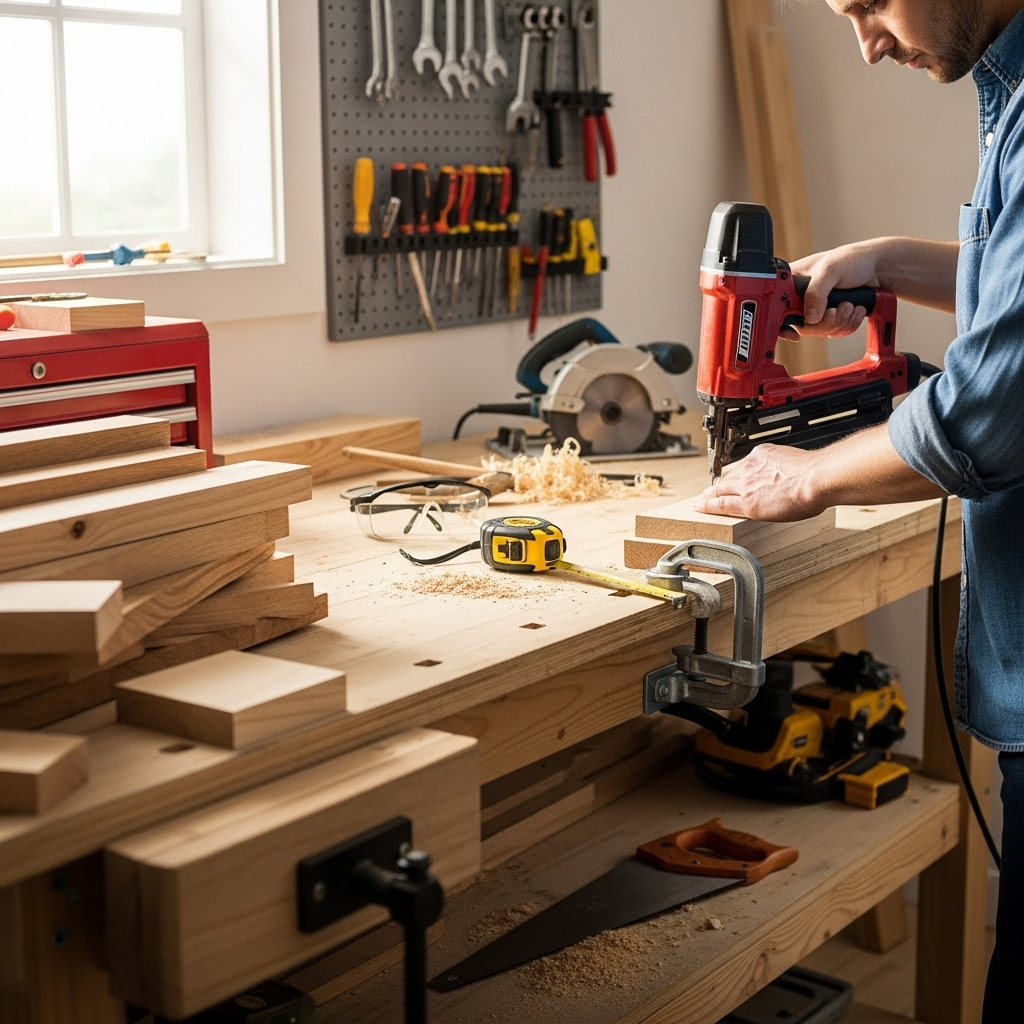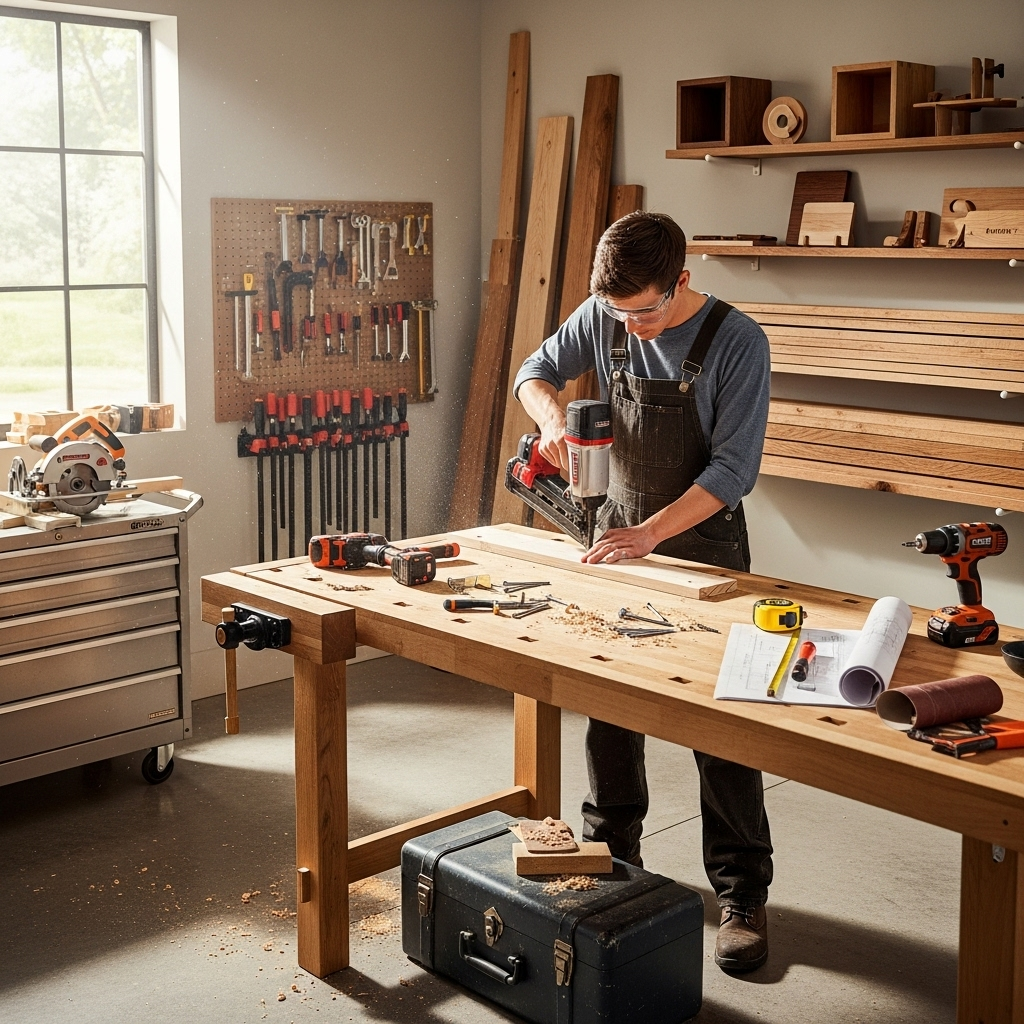The best pneumatic nail gun for crown molding makes installation faster, cleaner, and more professional. For DIYers, a lightweight, angled finish nailer (15 or 16 gauge) with adjustable depth control is ideal for securely fastening intricate crown molding without damaging the wood.
Installing crown molding can transform a room, adding a touch of elegance and finish. But wrestling with a hammer and nails for such a delicate job can be a recipe for frustration, leading to bent nails, splintered wood, and a less-than-perfect look. That’s where a pneumatic nail gun comes in. It’s a game-changer, making this project not only achievable for beginners but also a joy for experienced woodworkers. Forget the struggle; a good nail gun makes driving nails a breeze.
In this guide, we’ll walk you through everything you need to know to choose the perfect nail gun for your crown molding projects and use it like a pro. We’ll dive into what makes a nailer ideal for this specific task, explore the best options available, and provide clear, step-by-step instructions to help you get those perfect results.
Table of Contents
What Makes a Nail Gun Ideal for Crown Molding?
Crown molding has specific needs when it comes to joining it to walls and ceilings. It’s often made of softer woods, can have intricate profiles, and is installed at an angle, which presents unique challenges. A nail gun designed for this purpose needs to be precise, gentle, and powerful enough to do the job right.
Here are the key features to look for:
Gauge Size and Type
The gauge refers to the thickness of the nail the gun drives. For crown molding, you generally don’t need heavy-duty framing nails. Instead, you’re looking for thinner nails that are less likely to split the wood and create minimal visible holes.
- 16-Gauge Finish Nailers: These are the workhorses for most trim work, including crown molding. They drive nails that are about 1.6mm thick. The holes they leave are small and can be easily filled and blended with the molding.
- 15-Gauge Finish Nailers (Angled): These drive slightly thicker nails (around 1.8mm) but are often angled. The angle is crucial for crown molding because it allows you to drive nails from the shoe (the part that meets the ceiling) or the wall side at an awkward angle directly into the wall stud or ceiling joist without the nailer head hitting the molding itself. This is often considered the “best” choice for crown molding.
- 18-Gauge Brad Nailers: While good for very fine trim, 18-gauge nails (around 1mm thick) might not provide quite enough holding power for larger or heavier crown molding pieces, especially overhead. Usually, you’ll want something more robust.
Magazine Angle
As mentioned, the angle of the nailer’s magazine is vital. Crown molding is installed at an angle (typically around 38-55 degrees) to fit the corner between the wall and ceiling. An angled nailer allows you to position the gun correctly to drive the nail into the framing members at the necessary inward angle. This is a non-negotiable feature for efficient and effective crown molding installation.
Depth Adjustment
This feature allows you to control how far the nail is driven into the wood. You want nails to be flush with or slightly countersunk into the molding so they can be easily filled. Too deep, and you risk splintering the wood or creating a hole that’s too large to conceal. Too shallow, and the nails will stick out, making finishing impossible. Most modern finish nailers have an easy-to-use dial or lever for this.
Weight and Ergonomics
You’ll be holding the nail gun overhead for extended periods. A lightweight tool with a comfortable grip will significantly reduce fatigue, allowing you to work longer and more accurately. Poorly balanced or heavy tools can lead to mistakes and strain.
Power Source
Pneumatic nail guns require an air compressor. While this adds an extra piece of equipment, it offers consistent power and is generally more reliable and longer-lasting than cordless electric or battery-powered options for demanding tasks. The air compressor also powers other tools, making it a versatile investment for a home workshop.
Jam Clearing
Nail jams happen. A good nailer will have a tool-less jam clearing mechanism, allowing you to quickly and easily remove a jammed nail without needing extra tools, so you can get back to work without significant interruption.
Top Pneumatic Nail Guns for Crown Molding

Choosing the right nail gun can feel overwhelming with so many options. Based on the criteria above, here are some highly-regarded pneumatic nailers excellent for crown molding. Remember that specific models are always being updated, so always check the latest reviews and specifications.
DEWALT DWFP1550 15-Gauge Angled Finish Nailer
DEWALT is a trusted name in power tools, and their DWFP1550 is a solid choice for crown molding. It’s known for its reliability, consistent performance, and user-friendly features.
- Gauge: 15-gauge
- Magazine Angle: 20-degree
- Key Features: Tool-free jam release, adjustable depth control, rear exhaust to keep dust away from the user.
- Pros: Durable construction, good balance, excellent driving power.
- Cons: Can be slightly heavier than some competitors.
BOSTITCH SM1550BN Automatic 15-Gauge Angled Brad Nailer
BOSTITCH has a long history in the nailer market. The SM1550BN is a popular option offering a good blend of power, precision, and durability, making it suitable for intricate trim work like crown molding.
- Gauge: 15-gauge
- Magazine Angle: 20-degree
- Key Features: Dial-A-Depth™ depth control, side-load magazine, lightweight design for its class.
- Pros: Consistent performance, relatively lightweight, good value for money.
- Cons: Some users report occasional issues with nail collation.
PORTER-CABLE PC1585PR 15-Gauge 20-Degree Angled Finish Nailer
For budget-conscious DIYers, PORTER-CABLE often provides excellent value. The PC1585PR is a reliable angled finish nailer that gets the job done without breaking the bank.
- Gauge: 15-gauge
- Magazine Angle: 20-degree
- Key Features: Tool-free jam release, adjustable depth setting, magnesium body for lightweight operation.
- Pros: Affordable, lightweight, easy to maintain.
- Cons: May not be as durable for heavy-duty professional use as higher-end models.
Comparison Table: Pneumatic Nailers for Crown Molding
To help visualize the differences, here’s a quick comparison table. Please note that specifications can vary between specific sub-models and manufacturing years.
| Feature | DEWALT DWFP1550 | BOSTITCH SM1550BN | PORTER-CABLE PC1585PR |
|---|---|---|---|
| Gauge | 15-gauge | 15-gauge | 15-gauge |
| Magazine Angle | 20-degree | 20-degree | 20-degree |
| Weight (approx.) | 4.5 lbs | 4.2 lbs | 3.9 lbs |
| Depth Adjustment | Yes | Dial-A-Depth™ | Yes |
| Jam Clearing | Tool-Free | Tool-Free | Tool-Free |
| Ideal For | All-around trim, crown molding | Trim, crown molding, general woodworking | DIY trim projects, crown molding |
Essential Tools and Accessories
Besides the nail gun, you’ll need a few other items to make your crown molding project a success.
- Air Compressor: Any small to medium-sized pancake or hot dog style compressor will work for finish nailers. Look for one that can deliver at least 2-3 CFM (Cubic Feet per Minute) at 90 PSI (Pounds per Square Inch). Smaller compressors might struggle to keep up with continuous firing.
- Air Hose: A 25-foot or 50-foot 1/4-inch diameter hose is standard and provides enough reach. Make sure it has standard fittings that match your compressor and nailer.
- Safety Glasses: Non-negotiable! Always protect your eyes when using any power tool.
- Hearing Protection: Nail guns can be loud. Earplugs or earmuffs are recommended.
- Air Tool Oil: If your nailer requires manual oiling (check your manual), use specific pneumatic tool oil.
- Nails: Purchase the correct gauge and length of finish nails for your specific molding and nailer. For crown molding, common lengths range from 2 inches to 2.5 inches.
- Stud Finder: Essential for locating wall studs and ceiling joists to ensure secure fastening.
- Measuring Tape and Pencil: For precise measurements and marking.
- Miter Saw: For making accurate angled cuts on your molding.
- Caulk and Wood Filler: For filling nail holes and gaps.
- Putty Knife/Spatula: For applying wood filler.
- Sandpaper: For smoothing filled nail holes.
Setting Up Your Air Compressor and Nail Gun

Getting your equipment ready is the first step to a smooth installation. It’s simple, but doing it correctly ensures your nailer performs its best.
- Connect the Air Hose: Ensure your air compressor is unplugged. Connect one end of the air hose to the compressor’s outlet port and the other end to the nailer’s air inlet. Most fittings are quick-connect, so they should snap into place.
- Turn On the Compressor: Plug in and turn on your air compressor. Let it build up pressure to its cut-off point.
- Set the Air Pressure: This is critical. Most finish nailers operate optimally between 70-100 PSI. Consult your nail gun’s manual for the recommended operating pressure. Start on the lower end (e.g., 80 PSI) and adjust as needed. Too much pressure can overdrive nails and damage wood, while too little might not drive nails fully home. Many compressors have a regulator dial to set this.
- Load the Nails: Open the nailer’s magazine according to the manufacturer’s instructions. Insert a strip of the correct gauge and length nails, ensuring they are seated properly against the magazine follower. Close the magazine securely.
- Perform a Test Fire: With no nails loaded or in a safe direction (away from yourself and others), try firing the nailer. This helps confirm air pressure is reaching the gun and it’s operating correctly.
- Adjust Depth Setting: Before firing into your actual molding, test the depth setting on a scrap piece of wood similar to your molding material. Fire a nail. If it’s too proud (sticking out), increase the depth. If it’s too deep (buried too much, causing damage), decrease the depth. Aim for the nail head to be flush or slightly countersunk.
How to Install Crown Molding with a Pneumatic Nail Gun
Now for the exciting part – installing that beautiful crown molding! Using a nail gun makes this job significantly easier and cleaner.
Step 1: Plan and Measure
- Measure the lengths of each wall where molding will be installed.
- Using a miter saw, set the angle for your corners. For standard 90-degree inside corners, you’ll typically set your saw to 45 degrees. For outside corners, this also depends on the existing angle of the corner. For a standard 90-degree outside corner, you’d also use 45 degrees. Always check your specific angles, as rooms are rarely perfectly square. A framing square and angle finder can be very helpful here.
- For inside corners, cut one piece slightly long and test fit. Then cut the mating piece to get a perfect fit. For outside corners, it’s generally best to cut both pieces precisely and let them meet.
- Remember to account for any windows or doorways.
Step 2: Locate Framing Members
This is crucial for a secure installation. Crown molding needs to be nailed into the wall studs and ceiling joists.
- Use a reliable stud finder to locate the center of the studs along the wall where the molding will sit. Mark these locations lightly with a pencil.
- For the ceiling, use your stud finder to find the joists. You can often find these by going up into the attic if accessible or by systematically scanning the ceiling line. Mark these as well.
- A good rule of thumb from the U.S. General Services Administration’s Public Buildings Service states that framing members should be able to support structural loads, and proper fastening is key. Ensure your nails penetrate these structural elements for maximum hold. For crown molding, you aim to nail into both wall studs at the top and ceiling joists.
Step 3: Position and Nail the First Piece
- Hold the first piece of cut molding in place against the wall and ceiling. Ensure it sits snugly in the corner.
- Bring the nail gun up to the molding. The key is to angle the gun so the nails go through the molding and into the framing.
- For an inside corner, you’ll typically place the nail gun against the wall side of the molding, angling it inwards towards the studs. Drive a couple of nails along the top into the ceiling joists, again angling the gun to hit them.
- For an outside corner, you’ll angle the gun from the top so it drives into the studs, and then angle it from the side to catch the edge of the ceiling joist.
- Fire nails about 16-24 inches apart, ensuring each nail hits a stud or joist.
- Use the adjustable depth setting to set the nails slightly below the surface, ready for filling.
Step 4: Continue Installation
- Repeat the process for adjacent walls, ensuring your mitered cuts meet precisely at the corners.
- When you need to join two pieces of molding on a long wall, you’ll make a scarf joint. This involves cutting two small, opposing angles (usually around 22.5 degrees) on the ends of the molding pieces. This creates a far less noticeable seam than a simple butt joint. Nail both pieces securely into the studs and joists.
- Pay close attention to the fit against the wall and ceiling. Small gaps can be addressed later with caulk, but a tight fit looks far more professional.
Step 5: Final Touches
- Once all molding is installed, inspect for any nails that didn’t set properly. You can gently tap them in with a nail set, or if they are only slightly proud, you might be able to use the nail gun again carefully.
- Fill all nail holes with a good quality wood filler or putty. Use a putty knife to apply it, slightly overfilling the hole.
- Once the filler is dry, lightly sand the filled areas smooth and flush with the molding surface.
- Caulk any small gaps between the molding and the ceiling or wall. Use paintable caulk.
- Prime and paint (or stain and seal, depending on your molding material) to finish.
Safety First Tips

Working with pneumatic tools requires attention to safety. Always remember these points:
- Read the Manual: Every tool is different. Familiarize yourself with your specific nail gun and compressor manual.
- Wear Safety Glasses
